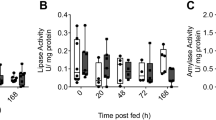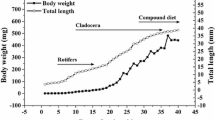Abstract
Postprandial physiological and morphological responses to feeding were examined in juvenile southern catfish (Silurus meridionalis Chen) that had consumed a loach (Misgurnus anguillicaudatus Cantor) meal equivalent to 6 % of the body mass of the catfish. The gastric evacuation rate (GER) peaked at 4 h postfeeding, averaging 0.36 g food weight h−1, at which time 14 % of the ingested meal had passed into the intestine. Less than 10 % of the ingested meal remained in the stomach at 24 h postfeeding. Pepsin activity peaked at 8 h postfeeding, reaching a level approximately twofold higher than the prefeeding level. Pancreatic trypsin activity peaked at 16 h postfeeding, reaching a level 4.5-fold higher than the prefeeding level. Peaks in lipase activity in both the proximal and middle intestinal segments occurred at 16 h, reaching 2.8- and 2.4-fold higher levels than the prefeeding level, respectively, while the activity in the distal intestine segment reached a level 2.9-fold higher than the prefeeding level at 24 h postfeeding. With respect to amylase activity, only the middle intestinal segment exhibited a change, first an increase and then a decrease, after feeding. Feeding also triggered an approximately 200 % increase in the metabolic rate and resulted in 44.6 kJ kg−1 being expended on specific dynamic action, equivalent to 16.1 % of the meal’s energy. In terms of organ size, the wet mass of the liver increased by 11 % at 24 h postfeeding, whereas the wet mass of the pancreas did not change. Except for a decrease in the thickness of the submucosa in the middle intestinal segment, the thickness of the intestinal fold, mucosa, submucosa, muscularis and serosa of each intestinal segment did not change significantly with feeding. These results suggest that the continuum of physiological responses observed with respect to metabolic increases, GER, regulation of pancreatic and intestinal digestive enzyme activities and liver wet mass to feeding corresponds to the changes in the demand on the digestive system in S. meridionalis. Moreover, species maintained stable gastrointestinal tract morphology during the short interval of repeated feeding.









Similar content being viewed by others
References
Anson ML (1938) The estimation of pepsin, trypsin, papain, and cathepsin with hemoglobin. J Gen Physiol 22:79–89
Blier PU, Dutil JD, Lemieux H, Belanger F, Bitetera L (2007) Phenotypic flexibility of digestive system in Atlantic cod (Gadus morhua). Comp Biochem Physiol A 146:174–179
Bucking C, Wood CM (2006) Water dynamics in the digestive tract of the freshwater rainbow trout during the processing of a single meal. J Exp Biol 209:1883–1893
Bucking C, Wood CM (2008) The alkaline tide and ammonia excretion after voluntary feeding in freshwater rainbow trout. J Exp Biol 211:2533–2541
Buddington RK, Chen JW, Diamond JM (1987) Genetic and phenotypic adaptation of intestinal nutrient transport to diet. J Physiol 393:216–281
Christel CM, DeNardo DF, Secor SM (2007) Metabolic and digestive response to food ingestion in a binge-feeding lizard, the Gila monster (Heloderma suspectum). J Exp Biol 210:3430–3439
Cox CL, Secor SM (2008) Matched regulation of gastrointestinal performance in the Burmese python Python molurus. J Exp Biol 211:1131–1140
Debnath D, Pal AK, Sahu NP, Yengkokpam S, Baruah K, Choudhury D, Venkateshwarlu G (2007) Digestive enzymes and metabolic profile of Labeo rohita fingerlings fed diets with different crude protein levels. Comp Biochem Physiol B 146:107–114
Erlanger BF, Kokowsky N, Cohen W (1961) The preparation and properties of two new chromogenic substrates of trypsin. Arch Biochem Biophys 95:271–278
Fu SJ, Xie XJ (2005) Effect of dietary carbohydrate levels on the growth performance in Silurus meridionalis Chen. Acta Hydrobiol Sin 29:393–398
Fu SJ, Xie XJ, Cao ZD (2005a) Effect of meal size on postprandial metabolic response in southern catfish (Silurus meridionalis). Comp Biochem Physiol A 140:445–451
Fu SJ, Xie XJ, Cao ZD (2005b) Effect of feeding level and feeding frequency on specific dynamic action in Silurus meridionalis. J Fish Biol 67:171–181
Fu SJ, Zeng LQ, Li XM, Pang X, Cao ZD, Peng JL, Wang YL (2009) The behavioural, digestive and metabolic characteristics of fishes with different foraging strategies. J Exp Biol 212:2296–2302
German DP (2009) Do herbivorous minnows have “plug-flow reactor” guts? Evidence from digestive enzyme activities, gastrointestinal fermentation, and luminal nutrient concentrations. J Comp Physiol B 179:759–771
German DP, Neuberger DT, Callahan MN, Lizardo NR, Evans DH (2010) Feast to famine: the effects of food quality and quantity on the gut structure and function of a detritivorous catfish (Teleostei: Loricariidae). Comp Biochem Physiol A 155:281–293
Guinea J, Fernandez F (1997) Effect of feeding frequency, relative meal size and temperature on energy metabolism in Sparus aurata. Aquaculture 148:125–142
Hick JW, Bennett AF (2004) Eat and run: prioritization of oxygen delivery during elevated metabolic states. Respir Physiol Neurobiol 144:215–224
Iijima N, Tanaka S, Ota Y (1998) Purification and characterization of bile salt-activated lipase from the hepatopancreas of red sea bream, Pagrus major. Fish Physiol Biochem 18:59–69
Jobling M (1981) The influence of feeding on the metabolic rate of fishes: a short review. J Fish Biol 18:385–400
Karasov WH (1992) Test of the adaptive modulation hypothesis for dietary control of intestinal transport. Am J Physiol 267:R496–R502
Li B, Tao C, Huang Q, Jiang JB, Wang ZJ (2008) Histological observation of gastrointestinal tract of Nanorana parkeriwere. Sichuan J Zool 28:241–243
Li KG, Cao ZD, Fu SJ (2009) Analysis of gastric evacuation rate and its mathematical model in Chinese catfish (Silurus asotus Linnaeus). J Chongqing Norm Univ 26:1–4
Li XM, Cao ZD, Peng JL, Fu SJ (2010) The effect of exercise training on the metabolic interaction between digestion and locomotion in juvenile darkbarbel catfish (Peltebagrus vachelli). Comp Biochem Physiol A 156:67–73
Lignot JH, Helmstetter C, Secor SM (2005) Postprandial morphological response of the intestinal epithelium of the Burmese python (Python molurus). Comp Biochem Physiol A 141:280–291
Liu HR, Zhang YG (2001) The anatomy of the digestive system of Silurus meridionalis. J Quanzhou Norm Coll 19:66–70
Liu HR, Zhang YG (2002) Preliminary study on distribution and type of goblet cells in digestive tract of Silurus meridionalis. Sichuan J Zool 21:6–8
Luo YP, Xie XJ (2008) Effects of temperature on the specific dynamic action of the southern catfish, Silurus meridionalis. Comp Biochem Physiol A 149:150–156
McWilliams SR, Caviedes-Vidal E, Karasov WH (1999) Digestive adjustments in cedar waxwings to high feeding rate. J Exp Zool 283:394–407
Naya DE, Bozinovic F (2004) Digestive phenotypic flexibility in post-metamorphic amphibians: studies on a model organism. Biol Res 37:365–370
Naya DE, Farfan G, Sabat P, Mendez ME, Bozinovic F (2004) Digestive morphology and enzyme activity in the Andean toad Bufo spinulosus: hard-wired or flexible physiology? Comp Biochem Physiol A 140:165–170
Nilsson PA, Bronmark C (2000) The role of gastric evacuation rate in handling time of equal-mass rations of different prey sizes in northern pike. J Fish Biol 57:516–524
Ott BD, Secor SM (2007) Adaptive regulation of digestive performance in the genus Python. J Exp Biol 210:340–356
Overgaard J, Andersen JB, Wang T (2002) The effects of fasting duration on the metabolic responses to feeding in Python molurus: an evaluation of the energetic costs associated with gastrointestinal growth and upregulation. Phsiol Biochem Zool 75:360–368
Pang X, Cao ZD, Peng JL, Fu SJ (2010) The effects of feeding on the swimming performance and metabolic response of juvenile southern catfish, Silurus meridionalis, acclimated at different temperatures. Comp Biochem Physiol A 155:253–258
Persson L (1986) Patterns of food evacuation in fishes: a critical review. Environ Biol Fishes 16:51–58
Qu YJ, Liu ZW (2005) Effects of starvation and refeeding on digestive enzyme activity of juvenile Lutjanus sebae. Acta Oceanol Sin 29:86–99
Secor SM (2001) Regulation of digestive performance: a proposed adaptive response. Comp Biochem Physiol A 128:565–577
Secor SM (2005a) Evolutionary and cellular mechanisms regulating intestinal performance of amphibians and reptiles. Integr Comp Biol 45:66–78
Secor SM (2005b) Physiological responses to feeding, fasting and estivation for anurans. J Exp Biol 208:2595–2608
Secor SM (2009) Specific dynamic action: a review of the postprandial metabolic response. J Comp Physiol B 179:1–56
Secor SM, Diamond J (1995) Adaptive responses to feeding in Burmese pythons: pay before pumping. J Exp Biol 198:1313–1325
Shi BN (1980) The biological study on the southern catfish in the Jialing river. J Southwest Norm Univ 2:45–52
Starck JM (1999) Structural flexibility of the gastro-intestinal tract of vertebrates—implications for evolutionary morphology. Zool Anz 238:87–101
Starck JM, Beese K (2002) Structural flexibility of the small intestine and liver of garter snakes in response to feeding and fasting. J Exp Biol 205:1377–1388
Starck JM, Cruz-Neto A, Abe AS (2007) Morphological and physiological responses to feeding in the broad-nosed caiman (Caiman latirostris). J Exp Biol 210:2033–2045
Taylor CR, Weibel ER (1981) Design of the mammalian respiratory system. I. Problem and strategy. Respir Physiol 44:1–10
Weibel ER, Taylor R, Hoppeler H (1991) The concept of symmorphosis: a testable hypothesis of structure-function relationship. Proc Natl Acad Sci 88:10357–10361
Zalkah M, Bdolah A (1987) Dietary regulation of digestive enzyme levels in the water snake, Natrix tesselata. J Exp Zool 243:9–13
Zeng LQ, Zhang YG, Cao ZD, Fu SJ (2010) Effect of temperature on excess post-exercise oxygen consumption in juvenile southern catfish (Silurus meridionalis Chen) following exhaustive exercise. Fish Physiol Biochem 36:1243–1252
Zhang YG (2004) On the gross anatomy of the southern catfish Silurus meridionalis Chen. Southwest China Normal University Press, Chongqing, pp 26–28
Acknowledgments
We are very grateful to D-Y. Pu, L. Jin, B. Li, J-Q. HuangFu and X-H. Ma for their considerable technical assistance with the experiments presented here. Our sincere appreciation is extended to Dr. Donovan P. German for his kindness in editing this manuscript and for the assay protocols for the digestive enzyme activities. We also thank the two anonymous reviewers for their constructive comments on the previous draft of this manuscript. This study was funded by a grant to L-Q. Zeng from the Graduate Technological Innovation Foundation of Southwest University (GTIF-SWU, ky2009008) and a grant to Y-G. Zhang from the Agriculture Special Research Project of Non-profit Undertakings of China (ASRPNUC, 200903048). We declare that the experiments comply with the current laws of the country where the experiments were performed.
Author information
Authors and Affiliations
Corresponding author
Rights and permissions
About this article
Cite this article
Zeng, LQ., Li, FJ., Fu, SJ. et al. Effect of feeding on the function and structure of the digestive system in juvenile southern catfish (Silurus meridionalis Chen). Fish Physiol Biochem 38, 1459–1475 (2012). https://doi.org/10.1007/s10695-012-9634-0
Received:
Accepted:
Published:
Issue Date:
DOI: https://doi.org/10.1007/s10695-012-9634-0




